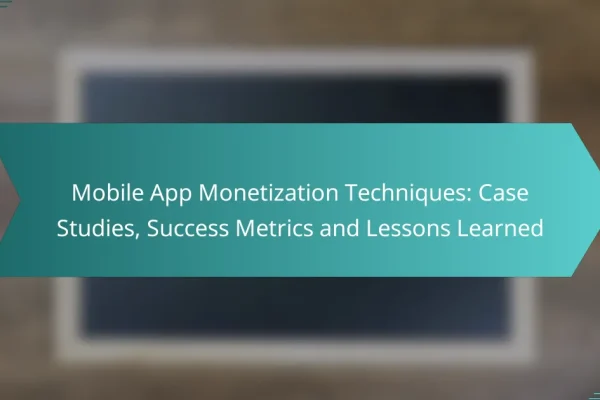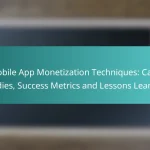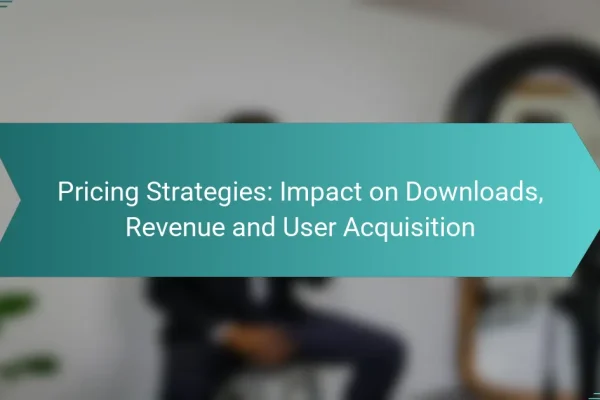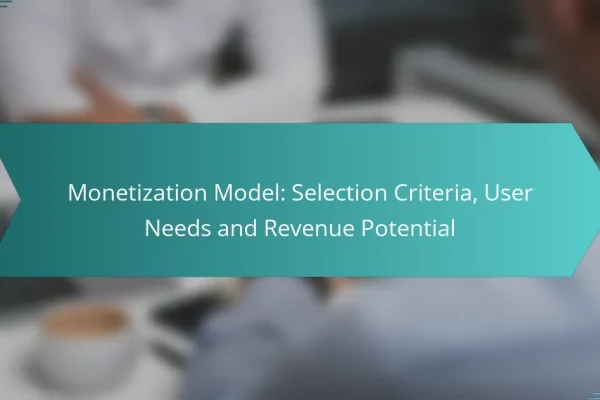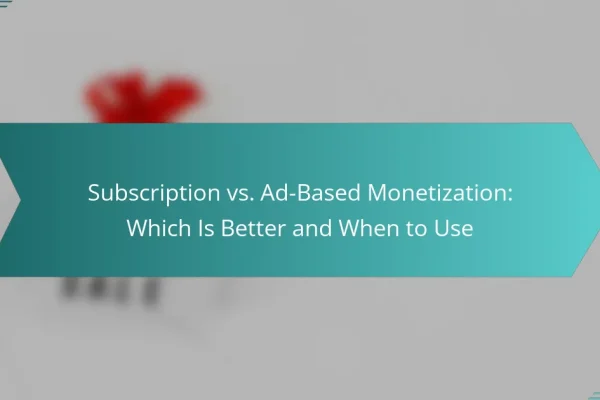What are effective app monetization strategies in Canada?
Effective app monetization strategies in Canada include a mix of in-app purchases, subscription models, ad-based revenue, freemium models, and sponsorships. Each method has unique advantages and considerations that can influence an app’s profitability.
In-app purchases
In-app purchases allow users to buy virtual goods or features within an app. This strategy works well for gaming apps, where users can purchase upgrades or additional content. It’s essential to balance the pricing to ensure it feels valuable without alienating users.
Consider offering a mix of low-cost and premium items to cater to different spending habits. For example, a game might offer cosmetic items for a few dollars while charging more for significant upgrades.
Subscription models
Subscription models charge users a recurring fee for access to premium content or features. This approach can provide a steady revenue stream and is popular in services like streaming or productivity apps. Monthly or annual plans can be offered, with discounts for longer commitments.
When implementing subscriptions, ensure that the value proposition is clear. Users should feel they are receiving ongoing benefits that justify their investment, such as regular updates or exclusive content.
Ad-based revenue
Ad-based revenue involves displaying advertisements within the app, earning money based on impressions or clicks. This strategy can be effective for free apps, as it allows users to access content without upfront costs. However, excessive ads can detract from user experience.
Consider using targeted ads to enhance relevance and engagement. Platforms like Google AdMob can help manage ad placements and optimize revenue. Aim for a balance between monetization and user satisfaction to maintain retention.
Freemium models
The freemium model offers a basic version of the app for free while charging for premium features. This approach attracts a larger user base, as individuals can try the app without financial commitment. The challenge lies in converting free users to paying customers.
To maximize conversions, clearly highlight the benefits of upgrading. Offering limited-time promotions or exclusive features can encourage users to make the leap to a paid version.
Sponsorships
Sponsorships involve partnering with brands to promote their products or services within the app. This strategy can provide additional revenue while enhancing user experience if done thoughtfully. Brands may offer financial support or resources in exchange for visibility.
When seeking sponsorships, ensure that the brands align with your app’s audience and values. Authentic partnerships can enhance user trust and engagement, while poorly matched sponsorships may lead to user dissatisfaction.
How do in-app purchases work?
In-app purchases allow users to buy virtual items or features within an app, enhancing their experience or unlocking additional content. These purchases can be one-time transactions or subscriptions, and they are typically processed through app stores like Google Play or the Apple App Store.
Users buy virtual goods
Users engage in in-app purchases primarily to acquire virtual goods, such as skins, characters, or power-ups. These items often enhance gameplay or provide aesthetic upgrades, making the experience more enjoyable. For example, a user might spend a few dollars to unlock a special character in a game.
It’s essential to offer a variety of purchase options, ranging from low-cost items to premium packages. This strategy caters to different user preferences and encourages more spending, as users can choose based on their budget and interest.
Common in gaming apps
In-app purchases are particularly prevalent in gaming apps, where they can significantly boost revenue. Many successful games adopt a freemium model, allowing users to download the app for free while offering in-app purchases for enhanced features or content. This model attracts a larger user base, increasing the potential for monetization.
Games often implement time-limited offers or exclusive items to create urgency, encouraging users to make purchases quickly. Developers should monitor user engagement and adjust pricing strategies to optimize revenue while maintaining a positive user experience.
What are the benefits of subscription models?
Subscription models offer several advantages, including a steady income stream and enhanced user loyalty. By charging users on a recurring basis, businesses can better forecast revenue and allocate resources effectively.
Predictable revenue stream
A subscription model creates a predictable revenue stream, which is essential for financial planning. Businesses can estimate their monthly or annual income based on the number of active subscribers, allowing for more strategic investments and budgeting.
For example, if a mobile app charges $10 per month and has 1,000 subscribers, it generates $10,000 monthly. This predictability can help in scaling operations and improving services.
Increased user engagement
Subscription models often lead to increased user engagement as customers feel invested in the service. Regular updates and new features can keep users interested and encourage them to utilize the app more frequently.
Additionally, subscribers are more likely to provide feedback, helping developers refine the app and enhance user experience. This ongoing interaction can foster a loyal community around the app, further driving retention.
How can ads be effectively integrated?
Ads can be effectively integrated into apps by ensuring they enhance user experience rather than disrupt it. This involves choosing the right ad formats, placements, and timing to maximize engagement and revenue without alienating users.
Using Google AdMob
Google AdMob is a popular platform for app monetization that allows developers to display ads within their applications. It supports various ad formats, including banner, interstitial, and native ads, enabling flexibility in integration.
To effectively use AdMob, developers should focus on optimizing ad placements to avoid disrupting user experience. For example, placing banner ads at the bottom of the screen can minimize interference while still generating revenue. Regularly analyzing performance metrics can help in adjusting strategies for better results.
Implementing rewarded ads
Rewarded ads offer users incentives, such as in-app currency or extra lives, in exchange for watching ads. This format tends to yield higher engagement rates since users willingly participate for rewards.
When implementing rewarded ads, it is crucial to balance the reward with the ad length to maintain user interest. A common practice is to keep ad durations between 15 to 30 seconds. Developers should also ensure that the rewards are meaningful enough to encourage participation without compromising the app’s economy.
What factors should be considered when choosing a monetization strategy?
Choosing a monetization strategy involves evaluating several key factors that can significantly impact your app’s success. Consider your target audience, the app category, competition, and the overall user experience to select the most effective approach.
Target audience preferences
Understanding your target audience’s preferences is crucial when selecting a monetization strategy. Different demographics may respond better to certain models, such as in-app purchases, subscriptions, or ads. For example, younger users might prefer free apps with ads, while professionals may be willing to pay for premium features.
Conducting surveys or analyzing user behavior can provide insights into what your audience values most. This data can guide you in choosing a strategy that aligns with their expectations and maximizes revenue potential.
App category and competition
The app category plays a significant role in determining the most suitable monetization strategy. For instance, gaming apps often thrive on in-app purchases and ads, while productivity apps may benefit more from subscription models. Analyzing competitors within your category can reveal successful strategies and gaps in the market.
Consider benchmarking against similar apps to understand their pricing models and user engagement tactics. This analysis can help you identify trends and make informed decisions to differentiate your app while optimizing revenue streams.
What are the emerging trends in app monetization?
Emerging trends in app monetization focus on adapting to user preferences and regulatory changes. Developers are increasingly prioritizing user experience while exploring innovative revenue models that align with privacy standards.
Increased focus on user privacy
With growing concerns over data security, app developers are emphasizing user privacy in their monetization strategies. This shift is driven by regulations such as the GDPR in Europe and CCPA in California, which mandate stricter data handling practices.
To comply with these regulations and maintain user trust, developers should implement transparent data collection practices. This includes clearly informing users about what data is collected and how it will be used, as well as providing options for users to control their data.
Additionally, consider adopting monetization models that do not rely heavily on user data, such as subscription services or in-app purchases. These models can help maintain revenue while respecting user privacy preferences.
